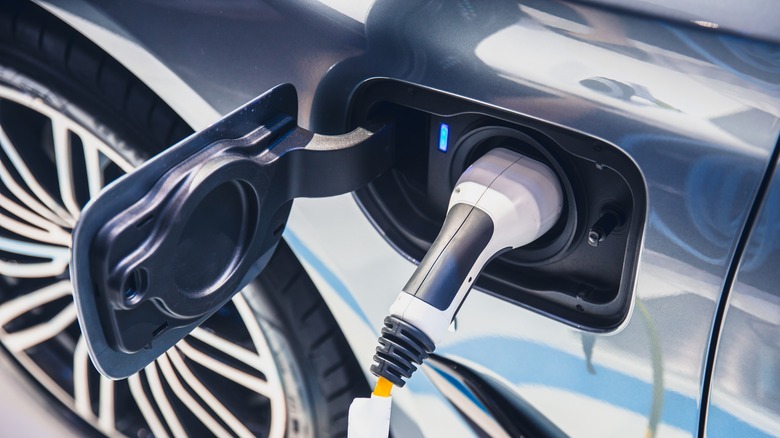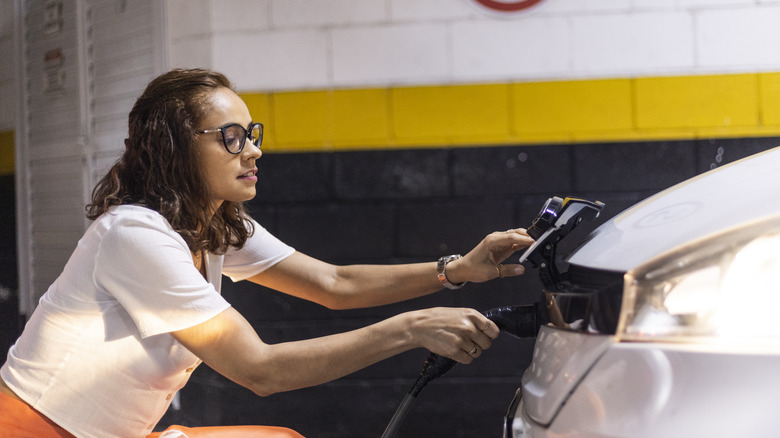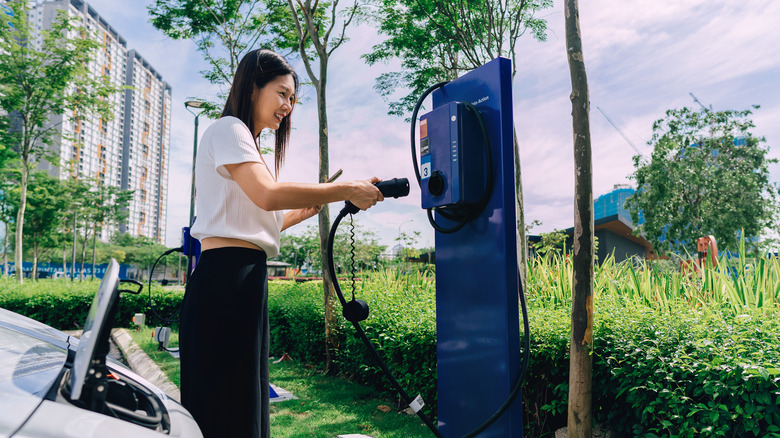Electric Car Charging Speeds: Why They're Still A Pain Point For Owners
Despite evolving technology and increasing affordability, electric vehicles have yet to take over our roads. According to the Bureau of Labor and Statistics, the share of total electric car sales versus all car sales in the United States only increased from 0.2% (2011) to 4.6% (2021). However, according to Consumer Reports, as more people become aware of the potential savings, which rack up to $12,000 on maintenance over an EV, and the environmental impact of switching away from traditional cars, there's hope that this share will increase soon.
In collaboration with Eurelectric, EY released a study that identified six essential factors that could help the world transition to electric vehicles for good. Two of these six essentials involve charging: a smart grid system and accessible charging infrastructure. EY estimates that over 400,000 public charge points are needed by 2025 to match the accelerated adoption in the U.S. alone. However, it's not just the quantity of charging points that matter, but also the speed of the charging itself. With so many old and new EV owners frustrated with their charging experiences, here's why accessibility of fast-charging stations is so essential.
Finding Faster Chargers
Most consumers typically want the fastest and most convenient option. Unfortunately, charging electric vehicles with our current technology and infrastructure requires significantly more effort than traditional gas vehicles.
According to the American Petroleum Institute, there are over 145,000 fueling stations across the United States. While the Alternative Fuels Data Center shares that there are 159,300 electric vehicle supply equipment (EVSE) or EV charging ports in the United States, it's important to understand that only 33,344 (20%) of them are fast charging (as of August 2023).
Not to mention, almost 30% of all EVSE ports are located in California, meaning drivers have fewer options in other states to recharge. With some states, such as Alaska, having as few as 114 EVSE ports, this carries several risks for all kinds of drivers.
For example, a driver hoping to use their electric vehicle across states may struggle to find fast charging points and end up staying overnight in an unfamiliar place. Or worse, drivers may encounter detours or traffic and realize they're not charged enough for their entire trip with no charger.
Why Faster Charging Matters
Electric vehicles and their charging capacity vary between the type of electric vehicle service equipment (EVSE) used. The Department of Transportation denotes the different charging speeds with 3 EV charging levels: Level 1, Level 2, and Direct Current Fast Charging (DCFC).
Although DCFCs can charge EVs up to 80% in as fast as 20 minutes, they take up less than a quarter of available charging ports in the U.S. For most EV owners, their electric cars will likely be charged with Level 2 EVSE, making up 77% of existing charging ports nationwide, which can take up to 10 hours to reach 80% capacity. On the other hand, Internal Combustion Engine Vehicles (ICEV) only take up to 10 minutes to refuel.
With this, it means ordinary people are likely comparing the effort of fueling up for 10 minutes versus 10 hours at home or in designated spaces. Effectively, this means that the current state of EV fast charging leads to a lot of range anxiety, affecting interstate, long-haul drivers, or people with no charging capabilities at home the most.
Challenges in EV Fast-Charging Technology
In an ideal world, charging your electric vehicle should be like charging your phone: easy to do and possible anywhere. However, most cities still do not have the electrical infrastructure necessary to handle the demands of electric vehicles and the facilities required to deal with EV battery-related issues.
Aside from its hidden carbon footprint, EV batteries also have several limitations, making them prone to various critical issues, such as heat management and degradation. Recently, news of lithium ion-powered EVs catching fire has become more common. According to the Environmental Protection Agency, over 240 lithium-ion battery fires broke out across 64 municipal waste facilities from 2013 to 2020. The problem has become so critical that a company in Germany, Rosenbauer, is actively working on EV-specific fire extinguishers to help firefighters manage EV-related fires.
Thankfully, with the ongoing efforts by the U.S. government to improve the EV battery supply chain, we're likely to see more development in EV fast-charging batteries in the near future. Aside from more affordable and efficient EV batteries, local manufacturers are more likely to be supported by legislation to manage charging requirements and end-of-life practices that increase with the demand.



